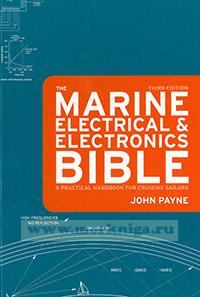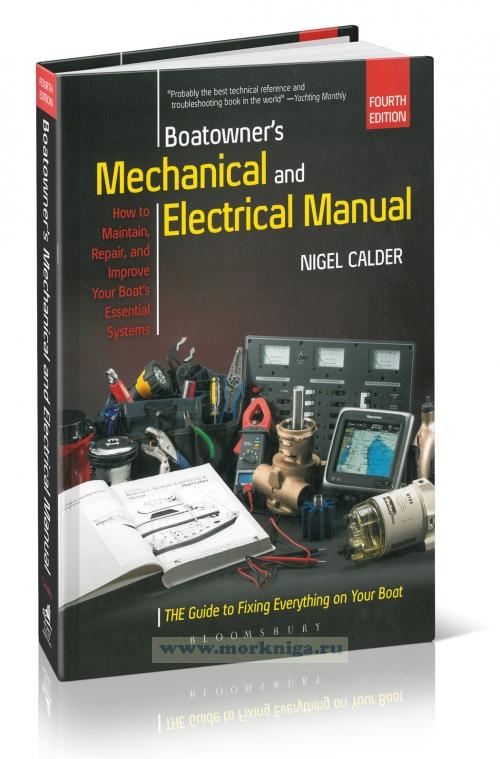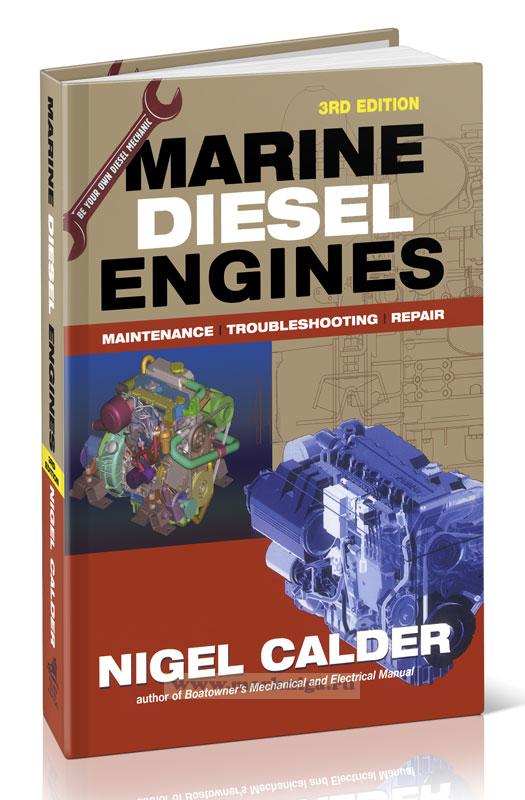The Marine Electrical & Electronics Bible. A practical handbook for cruising sailors. Third edition
Both cruising and racing yachts continue to evolve in many aspects, from hull design and exotic materials to the sailing rig and an increasing array of sophisticated electronic equipment. Quite often this equipment equals and is even superior to that found on many modern merchant vessels. One of the shortcomings is the frequent failure of the basic electrical systems that provide the power. Equipment and systems still often remain poorly planned, installed, and maintained. While the ABYC in the United States and the Recreational Craft Directive (RCD) in the UK/Europe set out standards that most manufacturers comply with, there are still many boat owners who fail to keep them up to these standards.
The Marine Electrical and Electronics Bible is specifically written to meet the real and practical requirements of cruising and racing yacht electrical and electronics systems. Electrical theory is explained only to allow the proper consideration, selection, installation, operation, maintenance, and troubleshooting of systems. I have deliberately set out to correct the dangerous illusion that vessel and automotive systems are alike except for the voltage levels. This third edition has a revised section on boat wiring, engine starting and battery charging and takes a "big ship" reliability based approach. Electrical problems are not an inevitable part of cruising and racing, and an acceptable level of reliability is possible, and in fact is necessary.
Marine electronics and systems technology still continues to advance at a fast pace. The greatest impact in the last few years has been the introduction of the Global Maritime Distress and Safety System (GMDSS). In this new edition, the marine communications chapters have been revised to reflect this important change and the ramifications are profound for all boaters. It will result in a much safer and more efficient distress and safety system afloat. Satellite telephones as well as e-mail and Internet are now an affordable reality along with electronic charting systems and network based instrument and data systems. One significant feature of the new equipment is the ability for boaters to take care of the installation themselves as most systems are plug-and-play.
An inherent danger with electronic navigation is the surrendering of seamanship skills. Far too many people sail offshore without the basic knowledge or ability to survive a loss of electronic navigation aids or the ability to maintain the equipment to keep them running. These high technology systems are only aids to navigation, and there is no substitute for seamanship, a well-found vessel, up to date charts, and the ability to find out where you are, using traditional methods.
This book captures and distills my 30 years of professional marine electrical experience on merchant vessels and in the offshore oil industry as a marine electrical engineer and surveyor, as well as my ownership of both cruising yachts and power vessels. In this book, I hope to answer many of the frequently asked questions and information requests that I get. I cannot overstress the importance of adopting a keep-it-simple approach to electrical systems and to marine electronics. Successful and trouble-free cruising depends on simplicity.
John Payne
Содержание
SECTION ONE
ELECTRICAL SYSTEMS
1. Batteries
Battery Selection. Battery Ratings. Battery Rating Selection. Sailing Load Calculations. Lead Acid Batteries. Battery Electrolyte. Battery Water. Plate Sulfation. Deep Cycle Batteries. Starting Batteries. Battery Safety. Battery Voltage and Installation. Battery Installation Recommendations. Battery Commissioning. Battery Routine Testing. Battery Maintenance. Battery Additives. Lead Acid Battery Troubleshooting. Low Maintenance Batteries. Gel Cell Batteries. Gel Cell Charging. AGM Batteries. Alkaline Batteries. NiCad Battery Characteristics. Small Appliance Batteries.
2. Battery-Charging Systems
Battery Charging Systems. Charging Cycles. Charging Efficiency. Charging System Configurations. Relay/Solenoid Configuration. Diode System. Electronic Battery Switches. Failure Analysis and System Redundancy. Failure Analysis and Risk Assessment. Systems Redundancy. Charging Systems. Maintenance Factors. FMEA Results. Multiple Alternator Charging System Configurations. Battery Charging Recommendations.
3. Alternator-Charging Systems
Alternator Charging. Field Circuits. Alternator Selection. Overvoltage and Surge Protection. Alternator Installation. Alternator Drive Pulley Selection. Alternator Maintenance. Alternator Faults and Failures. Alternator Troubleshooting. Alternator Terminal Designations. Alternator Remagnetization. Emergency Repairs and Getting Home. Diode Isolator Testing. Alternator Regulators. Alternator Regulator Sensing. Alternator Regulator Types. Standard Regulators. Regulator Polarity. Regulator Removal. Adverc Cycle Regulator. Balmar Regulator. Heart Interface Alpha (InCharge) 3-Stage Charge Regulator. PowerTap Regulator. Ideal Regulator. Battery Charge Settings. Alternator Manual Control Devices. Alternator Controllers. Diesel DC Charging Systems. Regulator Troubleshooting.
4. Alternative Energy Systems
Alternative Energy Charging Systems. Solar Systems. Solar Ratings, Efficiency and Regulation. Wind Charging Systems. Prop Shaft Charging Systems. Water Charging Systems. Fuel Cells. Construction and Operation. Fuel Cell Efficiency. Fuel Cell Cartridges.
5. Battery Chargers
Battery Chargers. Battery Charger Types. Multiple Battery Charging. Battery Charger Installation.
6. DC Systems Installation
DC Systems. Electrical Standards. DC System Voltages. DC Voltage Conversion. How to Wire and Rewire Your Boat. Wiring Considerations. Wiring Configurations. Distributed Systems. 42 Volt Power Systems. Circuit Control and Protection. Fuses. Circuit Breakers. Switchboard Troubleshooting. Conductor Selection. Conductor Installation. Instrument and Data Cable Installation. Grounding Systems. Conductor Terminations. Circuit Testing. Mast Cabling. Mast Cable Troubleshooting.
7. Lightning Protection
Lightning Protection. Lightning Physics. Lightning Components. Lightning Protection Zone. Lightning Protection Systems.
8. Corrosion
Corrosion. Galvanic Protection. Metal Nobility. Fiberglass and Wooden Boats. Anode Purity Standards. Anode Systems. Anode Number Calculations. Anode Bonding. Shaft Collar Anodes. Anodes for Fiberglass and Wooden Vessels. Anodes for Steel Vessels. Anodes for Aluminum Alloy Vessels. Corrosion Leakage Monitoring. Galvanic Isolators. Galvanic Isolator Selection and Installation. Galvanic Isolator Testing. Corrosion System Maintenance. Electrolytic (Stray Current) Corrosion. Steel/Alloy Hull Leakage Inspections.
9. Lighting Systems 164
Lighting Systems. Internal Lights. Dimmers and Voltage Stabilizers. Deck Lights. Lamp Bases. Spotlights. Navigation Lights. Navigation Light Technical Requirements.
10. DC Electrical Equipment
DC Electrical Equipment and Systems. Refrigeration Systems. Eutectic Refrigeration Systems. Compressors and Motors. Auxiliary Refrigeration Controls. Electric Refrigeration Systems. Hermetic Compressors. Refrigeration System Installation. Refrigeration System Troubleshooting. Air Conditioning Systems. Ventilation Fans. Diesel Heater Systems. Diesel Heater Troubleshooting. Anchor Windlass. Anchor Windlass Selection. Anchor Windlass Selection. Anchor Electrical Installation. Anchor Windlass Electrical Control. Anchor Windlass
Troubleshooting. Electric Furlers and Winches. Thruster Operations. Thruster Ratings. Thraster Types. Thruster Power Output Table. Thruster Power Supply. Thraster Control and Drive Motors. Thruster Maintenance and Servicing. Thruster Troubleshooting. DC Motors. Commutators. DC Motor Cleaning. Carbon Brashes. DC Motor Troubleshooting.
11. Water and Sewage Systems
Water Systems. Pressurized Water Systems. Water Tanks. Water Pressure Pumps. Pump Wiring. Water System Strainer. Water System Accumulators. Water Filters. Hot Water Calorifier. Diesel Hot Water Heaters. Water Pipes and Fittings. Water System Winterizing. Water System Troubleshooting. Desalination Systems. Desalinator Troubleshooting. Bilge Pump Systems. Bilge Alarms. Bilge Pump Installation. Bilge Pump Maintenance. Sewage Systems (Marine Sanitation Devices). MSD Systems. Toilet Systems. Shower Drain and Sink Systems.
12. Engine Electrical Systems
Engine Starting Systems. Electric Engine Starters. Starter Types. Starter Installation, Maintenance and Troubleshooting. Preheating Circuits. Preheater Maintenance. Preheater Troubleshooting. Engine Starting Recommendations. Engine Starting System Planning. Engine Starting System Configurations. Starting System Failure Mode Analysis. Engine Starting System Diagrams (Yanmar, Nanni, Perkins, Bukh, Volvo). Engine Electrical Troubleshooting.
Engine Alarms and Instrumentation. Pressure Monitoring. Temperature Monitoring. Exhaust Gas Temperature Monitoring. Engine Tachometers. Bilge and Tank Level Monitoring. Electrical System Monitoring. Hour Counters and Clocks. Acoustic Alarm Systems. Instrumentation Maintenance. Gauge Testing. Sensor Testing. Instrument Troubleshooting.
13. AC Power Systems
AC Power Safety. Shore Power Systems. 115 VAC 60Hz Single Phase System. 115/230 Volt Systems. 220/240 Volt Systems. 440/460 VAC 60Hz 3 Phase System. Transformers. Domestic Plugs. Shore Power Inverters. Power Management. AC Switchboards and Panels. AC Circuit Protection Principles. AC Short Circuit. Causes of a Short Circuit. Short Circuit Calculations. Short Circuit Protective Device. Selecting Protective Equipment. Cable Installation. Ground Leakage Protection. Circuit Testing. Generators. Generator Fuel Consumption. AC Alternators. AC Alternator Parameters. AC Alternator Rating Selection. Generator Rating Calculations. AC Load Analysis. AC Equipment Ratings. Generator Systems. Generator Protection. Alternator Protection. Alternator Maintenance. Generator Mechanical Systems. Generator Maintenance. Generator Operation. Gasoline Gensets. Generator Troubleshooting. Generator Electrical Troubleshooting. AC Machinery. Bearing Replacement. Inverters. Microwave Ovens.
SECTION TWO
ELECTRONICS SYSTEMS
14. Navigation Station Design
Navigation Station Design.
15. Radar
Radar. Radar Theory. Radar Scanners. Radar Ranges. Radar Displays. Radar Installation. Radar Operation. Radar Plotting. Radar Maintenance. Radar Troubleshooting.
16. Radar Reflectors
Radar Reflectors. Reflector Theory. Radar Reflection Polar Diagrams. Radar Fresnel Zones.
17. Autopilots
Autopilots. Autopilot Drive Systems. Autopilot Hydraulic System Troubleshooting. Autopilot Installation. Autopilot Controls. Autopilot Maintenance. Autopilot Troubleshooting.
18. Position Fixing Systems
Position Fixing Systems. Redundant Navigation
Systems. Global Positioning System (GPS). GPS Accuracy. GPS Error Sources. GLONASS Positioning System. Differential GPS (DGPS). Wide Area Augmentation System (WAAS). GPS Satellite Acquisition Modes. Space Weather and GPS. Effects. GPS Installation and Troubleshooting. Loran-C. Loran Transmission Chains. Chart Plotters. Cartography Systems. Chart Corrections and Updates. Chart Software.
19. Communications Systems
Global Maritime Distress and Safety Systems (GMDSS). GMDSS Operational Details. GMDSS Radio Distress Communications Frequencies. Digital Selective Calling (DSC). GMDSS Distress Call (Alert) Sequence. GMDSS False Alerts. GMDSS and Sailing Yachts. Satellite Communications Systems. COSPAS/SARSAT System. Satellite (L-Band) EPIRBs. 406 EPIRBs. 406-MHz EPIRB Registration. EPIRB Activation Sequence. EPIRB Operation. Rescue Reaction Times. Battery Life and Transmit Times. EPIRB Maintenance. Personal Locator Beacons (PLBs). Search and Rescue Transponders (SARTs). NAVTEX. VHF Radio. VHF Theory. VHF Propagation. VHF Operation. Radio Procedure. Distress, Safety and Urgency Calls. United States and Canada VHF Channels. International VHF Channels. VHF Frequencies. Caribbean VHF Channels. Europe, UK, Mediterranean VHF Channels. South Africa VHF Channels. New Zealand VHF Channels. Australia VHF Channels. VHF Aerials. Aerial Cables and Connections. VHF Installation Testing. SSB/HF Radio. Space Weather Effects and HF Radio. Solar Cycles. Operation Requirements. HF Radio Frequencies and Bands. United States SSB Weather Frequencies. United States, Canada and Caribbean HF Frequencies. English Channel and Atlantic Frequencies. Mediterranean Radio Frequencies. Australia and New Zealand Radio Frequencies. South Africa Radio Frequencies. HF Radio Tuner Units. HF Radio Aerials. HF Radio Grounds. HF Radio Maintenance. HF Radio Troubleshooting. Standard Time Frequencies. Amateur (Ham) Radio. Ham Nets. E-mail Services. E-mail Service Providers. Satellite Services. Satellite System Installation. Weatherfax Receivers. Computer Based Weather Systems. Weather Fax Frequencies. Cellular Telephones.
20. Instrument Systems
Instrument Systems. Interfacing. Selection Criteria. Electronic Compasses. Speed Logs. Wind Instruments. Depthsounders, Echosounders and Fishfinders. Sonar Theory. Cone Angles. Transducer Cavitation. Frequencies and Power Output. Sounder
Installation. Sounder Maintenance and Troubleshooting. Forward Looking Sonar. Instrument Installation. Instrument Troubleshooting.
21. Interference
Interference. Noise Sources. Suppression Methods. Screening. Noise Troubleshooting. Cable Planning.
22. Safety Systems
Gas Detectors. Fire Detection Systems. Security Ssytems. Security Alarm Indication Systems.
23. Computers
Notebook Computer Systems. Computer System Options. Software Options. Computer Maintenance. Computer Troubleshooting.
24. Entertainment Systems
Music Systems. Video and DVD Players. Satellite Television. Terrestrial Television. TV Aerials. Satellite Radios.
25. Troubleshooting, Testing and Servicing
Troubleshooting. Troubleshooting Procedure. How to Use a Multimeter. Meter Maintenance. Before Calling Service Technicians. Spare Parts and Tools. Basic Three Language Electrical Glossary.
26. Service Directory
Installation and Service List. (United States/Canada, United Kingdom/Europe, Mediterranean, Caribbean, Australia, Pacific, Atlantic and Indian Oceans,
Sources and Literature
Acknowledgments
Index

 Boatowner’s Mechanical and Electrical Manual. Fourth Edition/Руководство судовладельца по механическим и электрическим системам
Boatowner’s Mechanical and Electrical Manual. Fourth Edition/Руководство судовладельца по механическим и электрическим системам  Marine Diesel Engines/Судовые дизельные двигатели
Marine Diesel Engines/Судовые дизельные двигатели